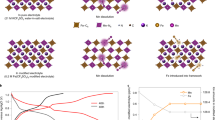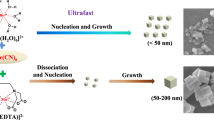Abstract
A new organic cathode namely potassium 2,6-dihydroxyanthraquinone (AQ26OK, theoretical capacity (CT) = 169 mA h g−1) is synthesized and fully characterized for K-ion batteries. AQ26OK is called polyanionic organic cathode because it has a polyanionic organic skeleton (−2 valent) and two strong ionic K-O bonds. Consequently, the polyanionic AQ26OK is hardly soluble into most organic liquid electrolytes. In half cells (0.3–3.4 V vs. K+/K) using 1 mol L−1 KPF6 in dimethoxyethane, AQ26OK delivers a highly stable specific capacity of 201 mA h g−1@50 mA g−1 over 450 cycles (4-month test) and realizes ~106 mA h g−1 for 3200 cycles at 500 mA g−1. Using the reduced state (K4TP) of potassium terephthalate (K2TP) as the organic anode, the resulting K4TP II AQ26OK organic potassium ion batteries can display a highly stable average discharge capacity of 135 mA h g−1cathode over 250 cycles at 100 mA g−1 and ~47 mA h g−1 for 1000 cycles at 500 mA g−1 during the working voltage of 0.01–3.1 V. To the best of our knowledge, AQ26OK is among the best stable cathodes reported for K ion batteries.

摘要
有机小分子电极材料普遍会溶解在电解液中. 本文报道了一个新型有机小分子化合物蒽醌-2,6-二羟基钾(AQ26OK, 理论比容量:169 mA h g−1)作为钾离子电池的正极材料. AQ26OK在大π共轭蒽醌的基础上含有2个强的O-K离子键, 使得有机框架为−2价. 因此, AQ26OK可以称为多阴离子有机电极材料. AQ26OK在醚类电解液中基本不溶, 从而在钾离子电池中展现出较高的循环稳定性. 在半电池中(0.3–3.4 V), 使用1 mol L−1 KPF6 乙二醇二甲醚作为电解液, AQ26OK在50 mA g−1的小电流下可以达到201 mA h g−1的比容量, 且可以稳定循环超过450圈(寿命至少4个月); 其在大电流(500 mA g−1)下可以达到106 mA h g−1的比容量且循环3200圈. 在使用对苯二甲酸钾还原态(K4TP)作为有机负极的全有机钾离子电池中, 此K4TP IIAQ26OK有机钾离子电池(0.01–3.0 V)在小电流(100 mA g−1)下可以稳定循环超过250圈且平均放电比容量约为135 mA h g−1; 其在大电流(500 mA g−1)下循环1000圈的平均比容量约为47 mA h g−1. AQ26OK是目前钾离子电池有机正极中最稳定的材料之一.
Similar content being viewed by others
References
Eftekhari A, Jian Z, Ji X. Potassium secondary batteries. ACS Appl Mater Interfaces, 2017, 9: 4404–4419
Hwang JY, Myung ST, Sun YK. Recent progress in rechargeable potassium batteries. Adv Funct Mater, 2018, 28: 1802938
Ji B, Yao W, Zheng Y, et al. A fluoroxalate cathode material for potassium-ion batteries with ultra-long cyclability. Nat Commun, 2020, 11: 1225
Zhang SS. Identifying rate limitation and a guide to design of fast-charging Li-ion battery. InfoMat, 2020, 2: 942–949
Wang B, Yuan F, Li W, et al. Rational formation of solid electrolyte interface for high-rate potassium ion batteries. Nano Energy, 2020, 75: 104979
Zeng L, Liu M, Li P, et al. A high-volumetric-capacity bismuth nanosheet/graphene electrode for potassium ion batteries. Sci China Mater, 2020, 63: 1920–1928
Hu Y, Tang W, Yu Q, et al. In situ electrochemical synthesis of novel lithium-rich organic cathodes for all-organic li-ion full batteries. ACS Appl Mater Interfaces, 2019, 11: 32987–32993
Liang Y, Luo C, Wang F, et al. An organic anode for high temperature potassium-ion batteries. Adv Energy Mater, 2019, 9: 1802986
Zhou J, Liu Y, Zhang S, et al. Metal chalcogenides for potassium storage. InfoMat, 2020, 2: 437–465
Rajagopalan R, Tang Y, Ji X, et al. Advancements and challenges in potassium ion batteries: A comprehensive review. Adv Funct Mater, 2020, 30: 1909486
Bie X, Kubota K, Hosaka T, et al. A novel K-ion battery: Hexacyanoferrate (II)/graphite cell. J Mater Chem A, 2017, 5: 4325–4330
Hosaka T, Kubota K, Hameed AS, et al. Research development on K-ion batteries. Chem Rev, 2020, 120: 6358–6466
Fan L, Ma R, Zhang Q, et al. Graphite anode for a potassium-ion battery with unprecedented performance. Angew Chem Int Ed, 2019, 58: 10500–10505
Lei K, Wang C, Liu L, et al. A porous network of bismuth used as the anode material for high-energy-density potassium-ion batteries. Angew Chem Int Ed, 2018, 57: 4687–4691
Tian B, Zheng J, Zhao C, et al. Carbonyl-based polyimide and polyquinoneimide for potassium-ion batteries. J Mater Chem A, 2019, 7: 9997–10003
Fan L, Ma R, Wang J, et al. An ultrafast and highly stable potassium-organic battery. Adv Mater, 2018, 30: 1805486
Zhao J, Yang J, Sun P, et al. Sodium sulfonate groups substituted anthraquinone as an organic cathode for potassium batteries. Electrochem Commun, 2018, 86: 34–37
Li C, Xue J, Ma J, et al. Conjugated dicarboxylate with extended naphthyl skeleton as an advanced organic anode for potassium-ion battery. J Electrochem Soc, 2018, 166: A5221–A5225
Lei K, Li F, Mu C, et al. High K-storage performance based on the synergy of dipotassium terephthalate and ether-based electrolytes. Energy Environ Sci, 2017, 10: 552–557
Hu Y, Ding H, Bai Y, et al. Rational design of a polyimide cathode for a stable and high-rate potassium-ion battery. ACS Appl Mater Interfaces, 2019, 11: 42078–42085
Xu L, Zhang J, Yin L, et al. Recent progress in efficient organic two-photon dyes for fluorescence imaging and photodynamic therapy. J Mater Chem C, 2020, 8: 6342–6349
Zhao Q, Wang J, Lu Y, et al. Oxocarbon salts for fast rechargeable batteries. Angew Chem Int Ed, 2016, 55: 12528–12532
Lee M, Hong J, Lopez J, et al. High-performance sodium-organic battery by realizing four-sodium storage in disodium rhodizonate. Nat Energy, 2017, 2: 861–868
Tang W, Liang R, Li D, et al. Highly stable and high rate-performance Na-ion batteries using polyanionic anthraquinone as the organic cathode. ChemSusChem, 2019, 12: 2181–2185
Li D, Tang W, Yong CY, et al. Long-lifespan polyanionic organic cathodes for highly efficient organic sodium-ion batteries. ChemSusChem, 2020, 13: 1991–1996
Li D, Tang W, Wang C, et al. A polyanionic organic cathode for highly efficient K-ion full batteries. Electrochem Commun, 2019, 105: 106509
Deng Q, Pei J, Fan C, et al. Potassium salts of para-aromatic dicarboxylates as the highly efficient organic anodes for low-cost K-ion batteries. Nano Energy, 2017, 33: 350–355
Hu Y, Tang W, Yu Q, et al. Novel insoluble organic cathodes for advanced organic K-ion batteries. Adv Funct Mater, 2020, 30: 2000675
Hu J, Liang R, Tang W, et al. Synthesis of polyanionic anthraquinones as new insoluble organic cathodes for organic Na-ion batteries. Int J Hydrogen Energy, 2020, 45: 24573–24581
Mu L, Lu Y, Wu X, et al. Anthraquinone derivative as high-performance anode material for sodium-ion batteries using ether-based electrolytes. Green Energy Environ, 2018, 3: 63–70
Guo C, Zhang K, Zhao Q, et al. High-performance sodium batteries with the 9,10-anthraquinone/CMK-3 cathode and an ether-based electrolyte. Chem Commun, 2015, 51: 10244–10247
Wang C, Tang W, Yao Z, et al. Using an organic acid as a universal anode for highly efficient Li-ion, Na-ion and K-ion batteries. Org Electron, 2018, 62: 536–541
Li B, Zhao J, Zhang Z, et al. Electrolyte-regulated solid-electrolyte interphase enables long cycle life performance in organic cathodes for potassium-ion batteries. Adv Funct Mater, 2018, 1807137
Deng T, Fan X, Chen J, et al. Layered P2-type K0.65Fe0.5Mn0.5O2 microspheres as superior cathode for high-energy potassium-ion batteries. Adv Funct Mater, 2018, 28: 1800219
Hameed AS, Katogi A, Kubota K, et al. A layered inorganic-organic open framework material as a 4 V positive electrode with high-rate performance for K-ion batteries Adv Energy Mater, 2019, 9: 1902528
Luo C, Xu GL, Ji X, et al. Reversible redox chemistry of azo compounds for sodium-ion batteries Angew Chem Int Ed, 2018, 57: 2879–2883
Tang K, Yu X, Sun J, et al. Kinetic analysis on LiFePO4 thin films by CV, GITT, and EIS. Electrochim Acta, 2011, 56: 4869–4875
Yang J, Su H, Wang Z, et al. An insoluble anthraquinone dimer with near-plane structure as a cathode material for lithium-ion batteries ChemSusChem, 2020, 13: 2436–2442
Tang M, Wu Y, Chen Y, et al. An organic cathode with high capacities for fast-charge potassium-ion batteries J Mater Chem A, 2019, 7: 486–492
Liao J, Hu Q, Yu Y, et al. A potassium-rich iron hexacyanoferrate/dipotassium terephthalate@carbon nanotube composite used for K-ion full-cells with an optimized electrolyte J Mater Chem A, 2017, 5: 19017–19024
Zhang C, Xu Y, Zhou M, et al. Potassium prussian blue nanoparticles: A low-cost cathode material for potassium-ion batteries Adv Funct Mater, 2017, 27: 1604307
Acknowledgements
This work was supported by the Fundamental Research Funds of University of Electronic Science and Technology of China (UESTC, ZYGX2019J027), the Open Foundation of State Key Laboratory of Electronic Thin Films and Integrated Devices of UESTC (KFJJ201915), and Sichuan Science and Technology Program (20YYJC3821)
Author information
Authors and Affiliations
Contributions
Fan C conceived and supervised the research ideas; Hu J performed the experiments, organized the data and wrote the raw paper; Tang W, Liu S, Hu Y and Lai H carried out the characterizations; Yan Y and Xu L provided data curation All authors contributed to the general discussion
Corresponding author
Additional information
Conflict of interest
The authors declare that they have no conflict of interest
Jiahui Hu is a master degree candidate at the School of Materials and Energy, University of Electronic Science and Technology of China (UESTC) under the supervision of Prof. Cong Fan. Her current research interests mainly focus on the design and synthesis of novel organic electrodes for Li/Na/K-ion batteries.
Cong Fan received his bachelor (2008) and PhD (2013) degrees in organic chemistry from Wuhan University. He is an associate professor at UESTC since August 2015. His current research interests are the skilled synthesis of organic electrode materials for rechargeable batteries.
Electronic supplementary material
Rights and permissions
About this article
Cite this article
Hu, J., Tang, W., Liu, S. et al. Insoluble polyanionic anthraquinones with two strong ionic O-K bonds as stable organic cathodes for pure organic K-ion batteries. Sci. China Mater. 64, 1598–1608 (2021). https://doi.org/10.1007/s40843-020-1556-9
Received:
Accepted:
Published:
Issue Date:
DOI: https://doi.org/10.1007/s40843-020-1556-9




